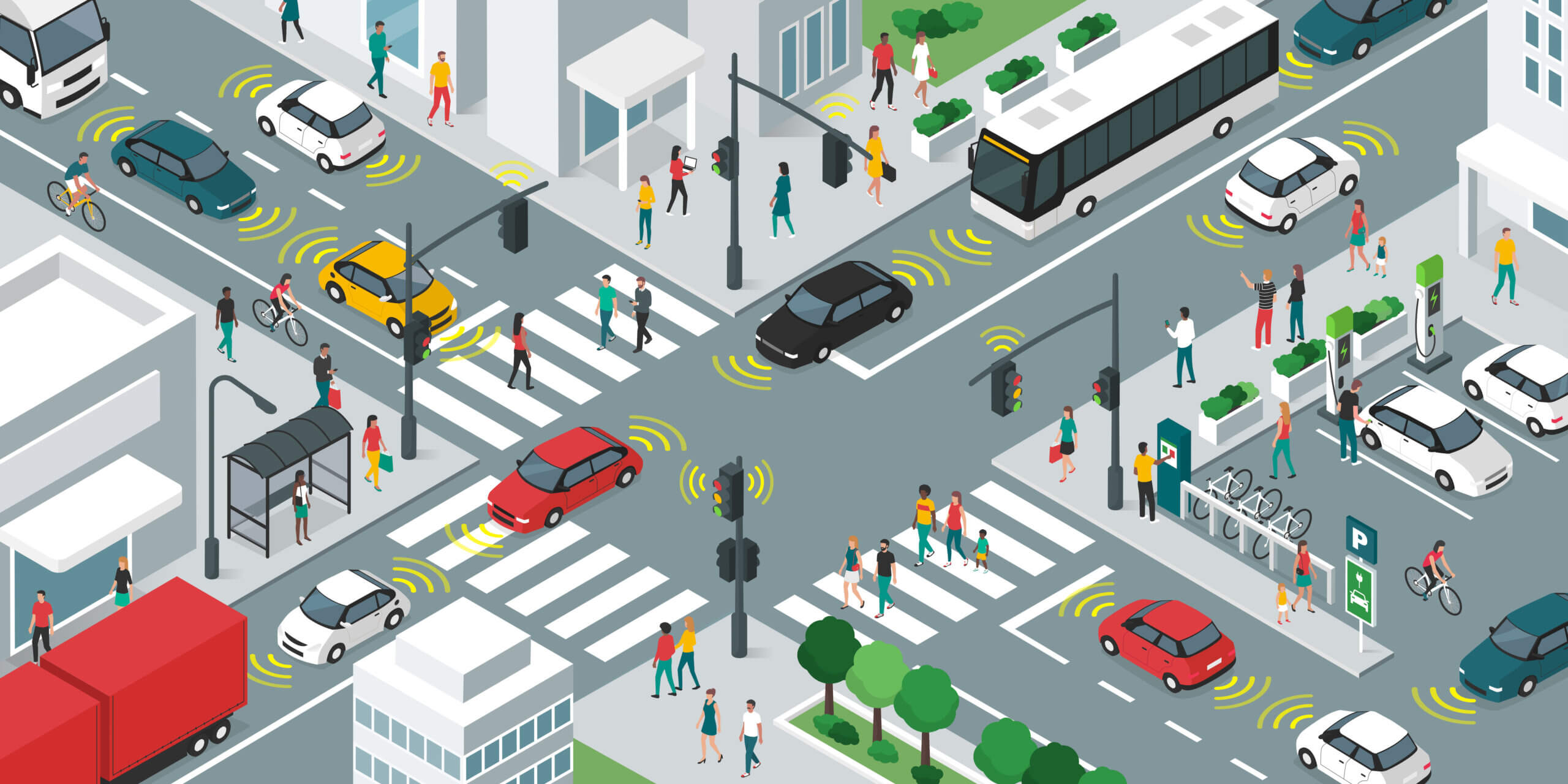The concept of smart homes and cities, where interconnected devices seamlessly communicate with one another to enhance convenience, efficiency and sustainability, has long been a futuristic vision. Thanks to the advancements in connected device engineering and Internet of Things (IoT) technologies, however, this vision is rapidly becoming a reality.
This blog post will explore the impact of connected home technologies and smart city IoT in our increasingly digital world. We will highlight various smart home product designs and smart city IoT engineering applications and delve into the potential benefits connected device engineering unlocks.
Contents
Connected Devices: Powering the Smart Home Revolution
Smart homes have emerged as one of the most prominent applications of connected device engineering. Defined as dwellings equipped with a range of connected devices and systems that users can remotely control and automate, smart homes provide convenience, comfort and improved energy efficiency. From smart thermostats to lighting systems to security cameras to voice assistants, smart appliances and more, the demand for smart home devices only continues expanding.

Let’s look at how these gadgets help redefine home efficiency, illuminate our spaces and provide unmatched peace of mind.
- Smart Energy Management: One of the significant contributions of connected device engineering to smart homes is improved energy management capabilities. Smart thermostats can learn user preferences and adjust heating and cooling systems based on occupancy patterns, weather forecasts and energy prices to optimize energy use. This optimization helps reduce energy consumption, resulting in cost savings and reduced environmental impact.
With diverse experience building connected smart home products, we understand how connecting a smart thermostat to Wi-Fi can help it learn the occupants’ schedules and temperature preferences over time, creating personalized profiles and custom heating and cooling schedules. Devices like the Amazon Smart Thermostat can detect when the home is unoccupied and automatically adjust the temperature to save energy.
- Connected Lighting Systems: Smart lighting systems offer greater control and energy efficiency than their traditional counterparts. Users can remotely control connected light bulbs and switches through smart home automation, smartphone apps or voice commands, turning off lights when they’re not needed, adjusting brightness levels or creating disparate lighting experiences for different occasions.
Philips Hue is a popular example of a smart lighting system that offers a wide range of colors and brightness settings, allowing users to create personalized ambiance in their homes while saving energy by adjusting lighting as required.
- Enhanced Security: Connected home technology has significantly improved home security. Smart cameras with motion detection and live streaming capabilities provide real-time monitoring, giving homeowners greater peace of mind when they’re away. Smart doorbell cameras enable remote communication with visitors, even when no one is home, adding an extra layer of security.
The Ring Video Doorbell is a well-known example that allows users to see, hear and speak to visitors through their smartphones, enhancing home security and deterring potential thieves or intruders.
Building Tomorrow’s Smart Cities Today
As connected device engineering revolutionizes smart homes, its impact on urban development and city management is equally transformative. Smart cities integrate IoT technologies into various aspects of urban life to improve efficiency, sustainability and livability for their inhabitants.
- Intelligent Transportation: From real-time traffic management to ridesharing services, enhanced public transportation and autonomous vehicles, connected device engineering is revolutionizing urban transportation systems and automotive software development. IoT sensors and smart traffic management systems monitor traffic flow, congestion and vehicle occupancy in real time to help city planners optimize traffic signal timings, reroute vehicles and improve overall traffic management.
For example, in Barcelona, Spain, the “Superblock” project uses connected sensors and traffic management algorithms to improve biodiversity, reduce vehicle traffic, prioritize pedestrians and cyclists and create more livable urban spaces.

Popular platforms like Lyft and Uber leverage connected devices and mobile apps to connect drivers and passengers. Additionally, connected devices help improve service reliability and the overall public transportation passenger experience, whether offering real-time information, tracking vehicles or purchasing tickets digitally. Finally, tomorrow’s self-driving cars rely on connected technology, using a network of sensors and communications devices to navigate safely and share data with other vehicles and infrastructure.
- Sustainable Energy Solutions: Smart cities harness the power of connected devices to optimize energy consumption and promote sustainable energy sources. IoT-enabled smart grids manage the generation, distribution and consumption of electricity, effectively balancing energy supply and demand and integrating renewable energy sources such as solar and wind power.
Copenhagen, Denmark, is a pioneering smart city that utilizes interconnected smart grids and IoT devices to achieve its carbon-neutrality goal by 2025. The city’s energy-efficient systems monitor and control power flows, reduce energy losses and incorporate renewable sources, significantly reducing carbon emissions while ensuring a stable and reliable energy supply.
Utilities also use connected devices to implement demand response programs, while facilities managers utilize the IoT to monitor and optimize the indoor experience, adjusting lighting and temperature based on occupancy and environmental conditions, which reduces energy consumption and enhances occupant comfort.
- Waste Management and Environmental Monitoring: Connected devices also help with waste management and environmental monitoring in smart cities. IoT sensors in waste bins monitor fill levels, optimizing waste collection routes and reducing unnecessary trips.
Additionally, environmental monitoring sensors track air and water quality, noise levels, and other environmental factors to ensure a healthier urban environment. This data is valuable for implementing measures to mitigate pollution and improve public health. By enhancing efficiency, sustainability and responsiveness, smart city IoT devices contribute to better resource management, reduced environmental impact and improved quality of life for residents.
Witnessing how connected devices revolutionize our homes and the urban landscape, let’s now focus on the numerous benefits that connected device engineering unlocks to improve how we live, work, learn and play.
Smart Home and Smart City IoT: The Benefits of Connected Life
As we venture into the realm of smart homes and smart cities, the fusion of connected devices and IoT technologies unlocks the immense promise of unparalleled convenience, efficiency and sustainability. This section offers a glimpse into the remarkable advantages connected device engineering brings to our daily lives.
- Convenience and Customization: By empowering homeowners and organizations across industries to control and automate various functions and personalize their environments, connected devices unlock incredible convenience and simplify daily routines and to-do’s. From lighting and heating to security, entertainment and everything in between, IoT control and automation empower people to manage their surroundings to suit their preferences — all at the tip of a finger or the sound of a voice.
- Energy Efficiency: Integrating connected devices in smart homes and cities offers substantial energy savings. Smart homes optimize heating, cooling and lighting, reducing energy waste and lowering utility bills for homeowners. In smart cities, IoT-based energy management systems ensure more efficient electricity use, promoting sustainability and environmental preservation. Whether helping optimize energy usage based on user preferences and occupancy or providing real-time data to address pollution and improve public health, connected sensors and devices often lead to reduced energy bills and a smaller carbon footprint.
- Sustainability: Connected device engineering in smart cities promotes sustainability on multiple fronts. With optimized transportation systems that are more user-friendly and efficient, fewer traffic jams and reduced fuel consumption contribute to lower emissions and improved air quality. Smart grids help reduce energy waste and carbon emissions. Efficient waste management practices leverage connected devices to reduce landfill waste and improve recycling rates, contributing to a greener environment.
- Urban Planning: Smart cities benefit from data-driven urban planning. The vast amount of data collected from connected devices allows city planners to make informed decisions about infrastructure development, traffic management, resource allocation and disaster preparedness. This data-driven approach enhances city resilience, enabling cities to respond effectively to population growth, climate change and resource scarcity.
Smart home and smart city IoT technologies are reshaping the way we live, work and interact with the world around us. From the convenience of smart homes to the efficiency gains in connected smart cities, connected device engineering’s impact is immense and multifaceted.
Smart Homes and Smart Cities: Embracing Our Connected Future
With IoT-enabled devices and interconnectivity, smart homes provide homeowners with unprecedented convenience, energy efficiency and security. On a larger scale, smart cities leverage connected devices and data analytics to optimize urban planning, transportation and resource management, promoting sustainability and improving citizens’ overall quality of life.
As connected devices and related technologies continue to evolve, the potential for further advancements in smart homes and cities is limitless. However, alongside these exciting opportunities, engineers must remain vigilant about security and privacy considerations to ensure connected devices’ safe and ethical implementation. By embracing the principles of sustainability, energy efficiency and data-driven urban planning, connected device engineering can shape a more sustainable, efficient and livable future for both individuals and urban communities worldwide.
Learn more about our services in smart home product design, IoT engineering and connected device development and reach our experts to discuss your project.
